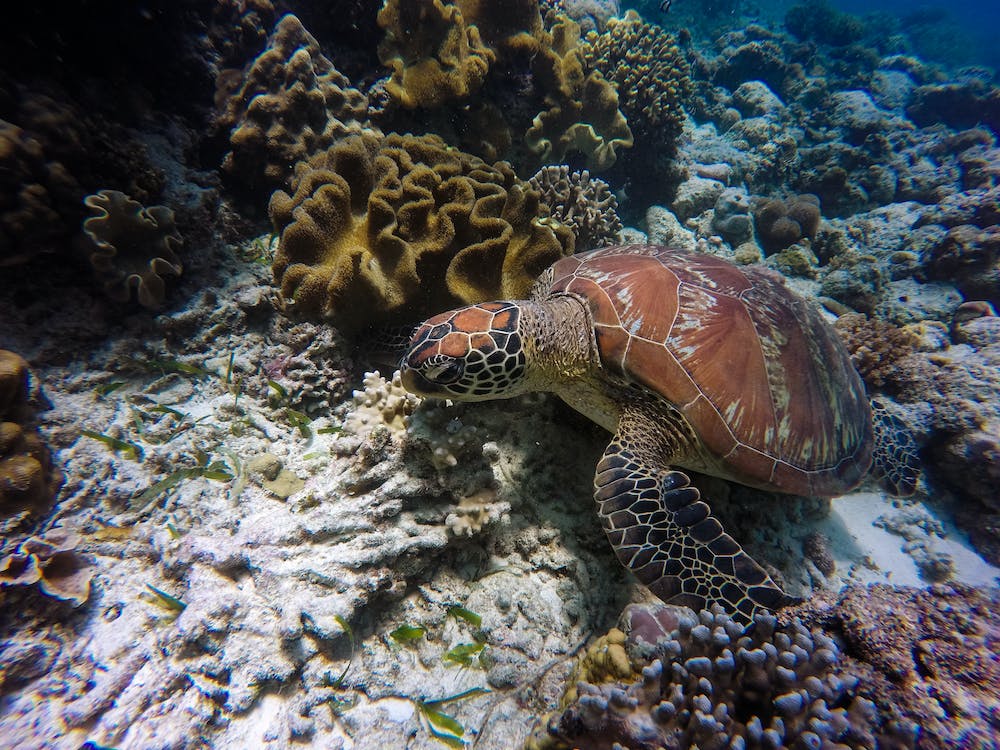Sea turtles sometimes called marine turtles, are reptiles of the order Testudines and of the suborder Cryptodira. For more than 100 million years, sea turtles have been essential to preserving the health of the waters across the world. Plastics on the other hand, are killing thousands of these sea turtles and the sad thing is that humans are to be blamed.
 One of the most significant environmental issues of our day is plastic trash. Each year, an estimated 8 million metric tons of plastic are added to the estimated 150 million metric tons already present in the ocean. Eighty percent of the plastic debris comes from land. Plastic from the streets, and roads washes into the ocean. It exits through storm drains and enters rivers and streams. It disperses from landfills and ends up everywhere in the stomachs of sea turtles. Research suggests that 52% of the world’s turtles have eaten plastic waste. The reasons are simple: a floating plastic bag can look like a lot of jellyfish, algae, or other species that make up a large component of the sea turtles’ diets. It is known that roughly 1,000 sea turtles every year die from ingesting plastic. A turtle has a 22% probability of passing away from consuming one piece of plastic, according to Australian researchers at the Commonwealth Scientific and Industrial Research Organization (CSIRO). Straws are also part of the problem, with them either going down the same pathway of ingested normal plastic, or they get stuck in a sea turtle’s nostril.
One of the most significant environmental issues of our day is plastic trash. Each year, an estimated 8 million metric tons of plastic are added to the estimated 150 million metric tons already present in the ocean. Eighty percent of the plastic debris comes from land. Plastic from the streets, and roads washes into the ocean. It exits through storm drains and enters rivers and streams. It disperses from landfills and ends up everywhere in the stomachs of sea turtles. Research suggests that 52% of the world’s turtles have eaten plastic waste. The reasons are simple: a floating plastic bag can look like a lot of jellyfish, algae, or other species that make up a large component of the sea turtles’ diets. It is known that roughly 1,000 sea turtles every year die from ingesting plastic. A turtle has a 22% probability of passing away from consuming one piece of plastic, according to Australian researchers at the Commonwealth Scientific and Industrial Research Organization (CSIRO). Straws are also part of the problem, with them either going down the same pathway of ingested normal plastic, or they get stuck in a sea turtle’s nostril.
Why is it important to save sea turtles?
Sea Turtles play a very important part within Marine ecosystems. A healthy ocean needs a healthy turtle. Here are a few good reasons why sea turtles are worth saving:
They keep the seagrass bed healthy
A Green Sea Turtle is one of the few big herbivores that regularly grazes on seagrass, which helps to maintain healthy seagrass beds by boosting the nutritional content and production of the seagrass blades.
Seagrass needs to be “mowed” by sea turtles in order for it to grow properly, as it is where fish, shellfish, and crustaceans reside. Regular green sea turtle grazing on seagrass causes the blades to receive more nutrients and thrive rather than overgrow and eventually decompose.
They maintain the Foundation of Coral Reefs
Although omnivore, hawksbill sea turtles prefer to consume sea sponges. Various species of Sea Turtles help maintain healthy seagrass beds, provide important nutrients to nesting dunes and ensure our Coral Reefs remain strong and healthy.
They consume jellyfish
Jellyfish tentacles are poisonous, but sea turtles are unaffected by their sting as they are reptiles that have thick skin that is covered with scales. Sea turtles can easily digest entire jellyfish, including their venom.
It’s crucial to manage the jellyfish population. Jellyfish eat fish eggs and larvae, thus if there are too many of them, there will be fewer fish.
They provide a habitat for many marine organisms
Loggerhead Sea Turtles are highly migratory turtles that have an enormous range that encompasses all but the most frigid waters of the world’s oceans. They are primarily found primarily in subtropical and temperate regions of the Atlantic, Pacific, and Indian Oceans, and in the Mediterranean Sea.
On the shells of Loggerhead Sea Turtles, more than 100 distinct species of epibionts have been found.
Sea turtles provide an important food source for other organisms
Sea turtles function as a delivery boy for some fish and shrimp species. Barnacles, algae and small creatures called epibionts attach themselves to the turtle and by carrying these around, the sea turtles provide a food source for fish and shrimp. As sea turtle populations decline, so does their ability to fulfill vital functions in the ocean ecosystems.
A healthy ocean requires the protection of sea turtles. Scientists claim that ocean plants known as phytoplankton are responsible for more than 50% of the world’s oxygen being produced in our oceans. As a result, the condition of our oceans is much more crucial to human survival.
What can we do to save turtles?
The truth is sea turtles are critically endangered. Six of the seven species of sea turtles are considered to be either critically endangered or threatened. Sea turtle populations have been seriously reduced worldwide through a number of human influences. Pollution of the waters via trash, chemicals, and discarded fishing nets, lines, and hooks is frequently ingested by sea turtles causing internal health issues. Humans are to be blamed but as humans, we also have the power to protect them. The good news is that you can take a lot of action to improve the future of sea turtles.
Here is how you can help save our sea turtles:
Reduce, reuse, and recycle your plastics
More than 14 million tons of plastic end up in the ocean every year. The best method to implement this guideline is to minimize your plastic waste. If that isn’t possible, try repurposing it instead, and only recycle as a last resort.
With so many companies offering plastic-free alternatives, it is easy to say no to plastics. The idea is to get to the bottom of the problem, so making an effort to use less plastic can help protect the planet’s limited resources and lessen the quantity of plastic that ends up in our oceans and landfills. Fortunately, by practicing the reduce, reuse and recycle method, we can drastically reduce your single-use plastic waste.
Shut off the lights
Lights and turtles have a connection? Yes. Sea turtles dig their nests at night because they enjoy the darkness. Sea turtles and their hatchlings may become confused by artificial lighting. This lowers their likelihood of successfully reproducing and of new hatchlings making it to the ocean. What is a hatchling’s chance of survival? Only about one in 1,000 turtles survive to adulthood. Depending on the species, turtles can lay between 3-200 eggs in one nest. Most of the Eggs won’t hatch and survive so Turtles usually have 1-10 surviving babies.
Participate in coastal clean-ups
Marine debris that has been exposed to the sun breaks down and releases chemicals into the ocean that could harm marine life and our health. So, cleanups also remove and reduce toxic chemicals in the water, which is good for everyone.
Organize a clean-up day with your friends and clear the beach of litter, give a presentation to your neighborhood or local school on things they can do to save sea turtles, and most importantly, talk to others about what they can do to make sure they are not putting these important creatures in danger.
Choose responsibly caught seafood
Buying products with the Responsible Choice logo is a simple way for shoppers to promote a more sustainable seafood industry. Seafood Watch lists “best choices,” which come from well-managed fisheries or aquafarms, as well as common fish to avoid because they’re overfished or harvested unsustainably.
Education is key
Many people are still mostly ignorant about the dangers and high risk of extinction that many species face throughout the world. To rescue the turtles, it is crucial to raise awareness through formal education, training, and networking with pertinent governmental and non-governmental organizations.
Together, we can help save sea turtles – and many other species that depend on our oceans!
Updated on: December 05, 2023

